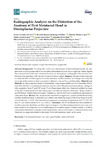Mostrar o rexistro simple do ítem
Radiographic Analysis on the Distortion of the Anatomy of First Metatarsal Head in Dorsoplantar Projection
| dc.contributor.author | Grande-del-Arco, Jessica | |
| dc.contributor.author | Becerro-de-Bengoa-Vallejo, Ricardo | |
| dc.contributor.author | Palomo-López, Patricia | |
| dc.contributor.author | López-López, Daniel | |
| dc.contributor.author | Calvo-Lobo, César | |
| dc.contributor.author | Pérez-Boal, Eduardo | |
| dc.contributor.author | Losa Iglesias, Marta Elena | |
| dc.contributor.author | Martín-Villa, Carlos | |
| dc.contributor.author | Rodríguez Sanz, David | |
| dc.date.accessioned | 2020-09-28T17:33:20Z | |
| dc.date.available | 2020-09-28T17:33:20Z | |
| dc.date.issued | 2020-08 | |
| dc.identifier.citation | Grande-del-Arco, J.; Becerro-de-Bengoa-Vallejo, R.; Palomo-López, P.; López-López, D.; Calvo-Lobo, C.; Pérez-Boal, E.; Losa-Iglesias, M.E.; Martin-Villa, C.; Rodriguez-Sanz, D. Radiographic Analysis on the Distortion of the Anatomy of First Metatarsal Head in Dorsoplantar Projection. Diagnostics 2020, 10, 552. https://doi.org/10.3390/diagnostics10080552 | |
| dc.identifier.issn | 2075-4418 | |
| dc.identifier.uri | http://hdl.handle.net/2183/26253 | |
| dc.description.abstract | [Abstract] Background: The diagnostic of flat and crest-shaped of first metatarsal heads has been associated as an important risk factor for hallux deformities, such as hallux valgus and hallux rigidus. The rounded form of the first metatarsal head on the dorsoplantar radiograph of the foot has been believed to be associated with the development of hallux valgus. Purpose: The aim of this study was to clarify the effect of tube angulation on the distortion of first metatarsal head shape, and verify the real shape of the metatarsal head in anatomical dissection after an X-ray has been taken. Materials and Methods: In this prospective study at Universidad Complutense de Madrid, from December 2016 to June 2019, 103 feet from embalmed cadavers were included. We performed dorsoplantar radiograph tube angulation from 0° until 30° every 5° on all specimens; then, two observers verified the shape of the first metatarsal head in the radiographs and after its anatomic dissection. Kappa statistics and McNemar Bowker tests were used to assess and test for intra and interobserver agreement of metatarsal shape. Results: We calculated the intraobserver agreement, and the results showed that the first metatarsal head is distorted and crested only when the angle of the X-ray beam is at 20° of inclination (p < 0.001). The interobserver agreement showed good agreement at 0°, 5°, 10°, 20°, and 25° and was excellent at 30° (p < 0.001). Conclusion: All of the studies that we identified in the literature state that there are three types of shapes of the first metatarsal head and relate each type of head to the diagnosis of a foot pathology, such as hallux valgus or hallux rigidus. This study demonstrates that there is only the round-shaped form, and not three types of metatarsal head shape. Therefore, no diagnoses related to the shape of the first metatarsal head can be made. | es_ES |
| dc.language.iso | eng | es_ES |
| dc.publisher | MDPI AG | es_ES |
| dc.relation.uri | https://doi.org/10.3390/diagnostics10080552 | es_ES |
| dc.rights | Atribución 4.0 Internacional | es_ES |
| dc.rights.uri | http://creativecommons.org/licenses/by/4.0/ | * |
| dc.subject | First metatarsal head | es_ES |
| dc.subject | Foot | es_ES |
| dc.subject | Radiological health | es_ES |
| dc.subject | Metatarsal bones | es_ES |
| dc.title | Radiographic Analysis on the Distortion of the Anatomy of First Metatarsal Head in Dorsoplantar Projection | es_ES |
| dc.type | info:eu-repo/semantics/article | es_ES |
| dc.rights.access | info:eu-repo/semantics/openAccess | es_ES |
| UDC.journalTitle | Diagnostics | es_ES |
| UDC.volume | 10 | es_ES |
| UDC.issue | 8 | es_ES |
| dc.identifier.doi | 10.3390/diagnostics10080552 |
Ficheiros no ítem
Este ítem aparece na(s) seguinte(s) colección(s)
-
GI-UDISAP - Artigos [196]






